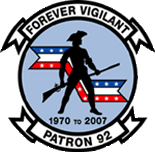
Patrol Squadron 10 (VP-10) is a United States Navy Patrol Squadron based at Naval Air Station Jacksonville in Jacksonville, Florida, United States. It is nicknamed the "Red Lancers" and is equipped with the Boeing P-8A Poseidon. It is the third squadron to be designated VP-10. The first VP-10 was redesignated VP-2D15 on 21 September 1927 and the second VP-10 was redesignated VP-25 on 1 July 1939.

Naval Air Station Brunswick, also known as NAS Brunswick or the Brunswick Naval Air Station, was a military airport located 2 miles (3.2 km) southeast of Brunswick, Maine, with a number of Navy-operated maritime patrol aircraft. As of November 28, 2009, the last aircraft left. The runways were permanently closed in January 2010. The base operated while the airport operated publicly under the name Brunswick Executive Airport until the base closed on May 31, 2011, as per the 2005 Base Realignment and Closure committee decision. Since then the base is known as Brunswick Landing. The Midcoast Regional Redevelopment Authority has been managing base redevelopment with high-tech business and industrial park. On April 2, 2011, the airport reopened as Brunswick Executive Airport.
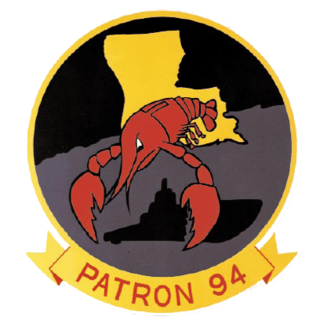
VP-94Crawfishers was a Patrol Squadron of the U.S. Navy Reserve. Originally established on 1 November 1970 at NAS Belle Chase, Louisiana, it was disestablished in September 2006. It was the second squadron to be designated VP-94, the first VP-94 was redesignated VPB-94 on 1 October 1944.
A Patrol Wing (PatWing) was a United States Navy aviation unit with the commander of a Patrol Wing known as the Commodore, the ComPatWing or COMPATWING. From 1 November 1942 to 30 June 1973 Patrol Wings were designated "Fleet Air Wings". On 26 March 1999 all then existing Pacific Fleet Patrol Wings were redesignated Patrol and Reconnaissance Wings and on 1 June 1999 all then existing Atlantic Fleet Patrol Wings were redesigned Patrol and Reconnaissance Wings with the Commodore designated as COMPATRECONWING or ComPatReconWing.

Naval Air Station South Weymouth was an operational United States Navy airfield from 1942 to 1997 in South Weymouth, Massachusetts. It was first established as a regular Navy blimp base during World War II. During the postwar era the base became part of the Naval Air Reserve Training Command, hosting a variety of Navy and Marine Corps reserve aircraft squadrons and other types of reserve units. Like most BRAC sites, environmental contamination was detected in 1986, and since 1993 numerous remedies and long term monitoring of ground water are in place. Since 2005, over 600 acres have been transferred to the affected towns for reuse, and in 2011 the Navy signed a $25 million contract to transfer its remaining land.

VP-23, Patrol Squadron 23, known as the Seahawks, was a U.S. Navy fixed-wing, anti-submarine and maritime Patrol Squadron based at Brunswick Naval Air Station, Brunswick, Maine, United States. It was established as Weather Reconnaissance Squadron Three (VPW-3) on 17 May 1946, redesignated as Meteorology Squadron Three (VPM-3) on 15 November 1946, redesignated Heavy Patrol Squadron (Landplane) Three (VP-HL-3) on 8 December 1947, and to Patrol Squadron Twenty Three (VP-23) on 1 September 1948 and disestablished on 28 February 1995. It was the second squadron to be designated VP-23, the first VP-23 was redesignated Patrol Bombing Squadron 23 (VPB-23) on 1 October 1944 and disestablished on 25 January 1946.
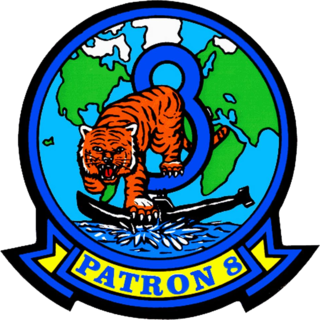
Patrol Squadron Eight (VP-8) is a U.S. Navy land-based patrol squadron stationed at Naval Air Station Jacksonville, Florida (USA). VP-8 is tasked to undertake maritime patrol, anti-submarine warfare (ASW), and intelligence, surveillance and reconnaissance (ISR) missions. The Squadron is equipped with the Boeing P-8A Poseidon.

Patrol Squadron 11 (VP-11), nicknamed Proud Pegasus, was a Patrol Squadron of the U.S. Navy. The squadron was established at NAS Quonset Point, Rhode Island on 15 May 1952 and was disestablished on 2 August 1997. It was the fourth squadron to be designated VP-11, the first VP-11 was redesignated VP-54 on 1 October 1937, the second VP-11 was redesignated VP-21 on 1 February 1941 and the third VP-11 was redesignated VPB-11 on 1 October 1944.
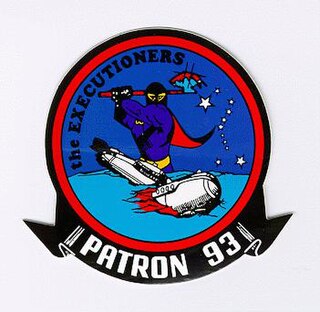
VP-93, nicknamed the Executioners, was a Patrol Squadron of the U.S. Navy Reserve. It was the second squadron to be assigned the VP-93 designation. The squadron was established on 1 July 1976 and disestablished 18 years later, on 30 September 1994. It flew the Lockheed P-3 Orion, and was based at NAF Detroit during its entire life. Units of the squadron made 17 major overseas deployments.

Fleet Logistics Support Squadron 64 (VR-64), nicknamed the Condors, is a logistics squadron of the U.S. Navy Reserve, based at Joint Base McGuire–Dix–Lakehurst. The squadron was established as Patrol Squadron 64 (VP-64) on 1 November 1970 and redesignated on 18 September 2004, after 34 years of service. It was based at NAS Willow Grove, Pennsylvania until it got transferred to Joint Base McGuire–Dix–Lakehurst in 2011. Units of the squadron made 26 major overseas deployments.
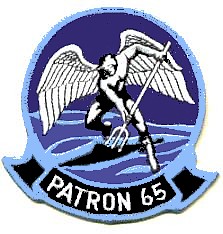
VP-65, nicknamed the Tridents, was a Patrol Squadron of the U.S. Navy Reserve. The squadron was established on 16 November 1970 at NAS Los Alamitos, California, and moved on 6 January 1971 to NAS Point Mugu. It was disestablished on 4 March 2006, after 35 years of service. Elements of the squadron made 22 major overseas deployments.

VP-67 was a Patrol Squadron of the U.S. Navy Reserve. The squadron was established on 1 November 1970 at NAS Memphis, Tennessee, where it was based for its entire life. It was disestablished on 30 September 1994, after 24 years of service. The squadron's nickname was the Golden Hawks, also unofficially called the Thunder Chickens. Elements of the squadron made 23 major overseas deployments.

VP-68 was a Patrol Squadron of the U.S. Navy Reserve. The squadron was established on 1 November 1970 at NAS Patuxent River, Maryland. Its home port moved to Naval Air Facility Washington in 1985. The squadron was disestablished on 16 January 1997, after 26 years of service. Its nickname was the Blackhawks from 1972 onward. Elements of the squadron made 28 major overseas deployments.

VP-90 was a Patrol Squadron of the U.S. Navy Reserve. The squadron was established on 1 November 1970 at NAS Glenview, Illinois, where it was based for the rest of its life. It was disestablished on 30 September 1994, after 25 years of service. The squadron's nickname was the Lions from 1974 onward. Elements of the squadron made 22 major overseas deployments.

This VP-44 was a long-lived Patrol Squadron of the U.S. Navy. The squadron was established on 29 January 1951 at NAS Norfolk, Virginia and disestablished 40 years later, on 28 June 1991, at NAS Brunswick, Maine. Units of the squadron made 40 major overseas deployments. Its nickname was the Golden Pelicans from 1961 to 1991, and it was also known as the Budmen from 1989 to 1991. The squadron had four different insignia during its lifetime, featuring a marlin, King Neptune, a cartoon pelican, and, finally, a more formal pelican design. It was the fourth squadron to be designated VP-44, the first VP-44 was redesignated as VP-61 on 6 January 1941, the second VP-44 was redesignated VPB-44 on 1 October 1944 and the third VP-44 was disestablished on 20 January 1950.

VP-6 was a long-lived Patrol Squadron of the U.S. Navy, nicknamed the Blue Sharks. Originally established as Bombing Squadron VB-146 on 15 July 1943, it was redesignated Patrol Bombing Squadron VPB-146 on 1 October 1944, redesignated VP-146 on 15 May 1946, redesignated Medium Patrol Squadron (Landplane) VP-ML-6 on 15 November 1946, redesignated VP-6 on 1 September 1948 and disestablished on 31 May 1993. It was the third squadron to be designated VP-6, the first VP-6 was disestablished on 3 May 1926 and the second VP-6 was disestablished on 20 June 1945.

Patrol Squadron 30 (VP-30) is a maritime patrol squadron of the United States Navy, established on 30 June 1960. It is based at Naval Air Station Jacksonville, Florida.
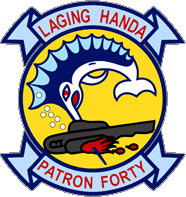
VP-40 is a Patrol Squadron of the U.S. Navy. The squadron was established on 20 January 1951. It is the second squadron to be designated VP-40, the first VP-40 was disestablished on 25 January 1950.
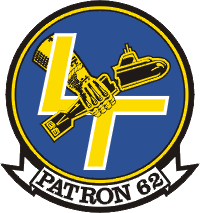
Patrol Squadron SIXTY TWO (VP-62) is a combat aviation squadron of the United States Navy Reserve. Since 31 July 2015, the squadron has been assigned to Commander, Maritime Support Wing, an Echelon IV organization under the Commander, Naval Air Force Reserve. Nicknamed the Broadarrows, the squadron flies the P-3C Orion maritime patrol aircraft from its home station of Naval Air Station Jacksonville, Florida, deploying worldwide. The squadron's aircraft can be identified by the stylized letters "LT" on the vertical stabilizer, the letter "L" being common to all U.S. Atlantic Fleet patrol aircraft, either Regular Navy or Navy Reserve, and the letter "T" being unique to VP-62. The stylized "LT" is also incorporated in the squadron's insignia as worn as a cloth patch on flight suits and flight jackets.
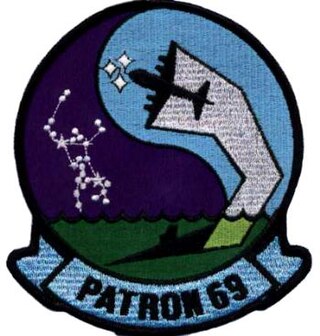
VP-69 is a Patrol Squadron of the United States Navy Reserve. The squadron was established on 1 November 1970.
